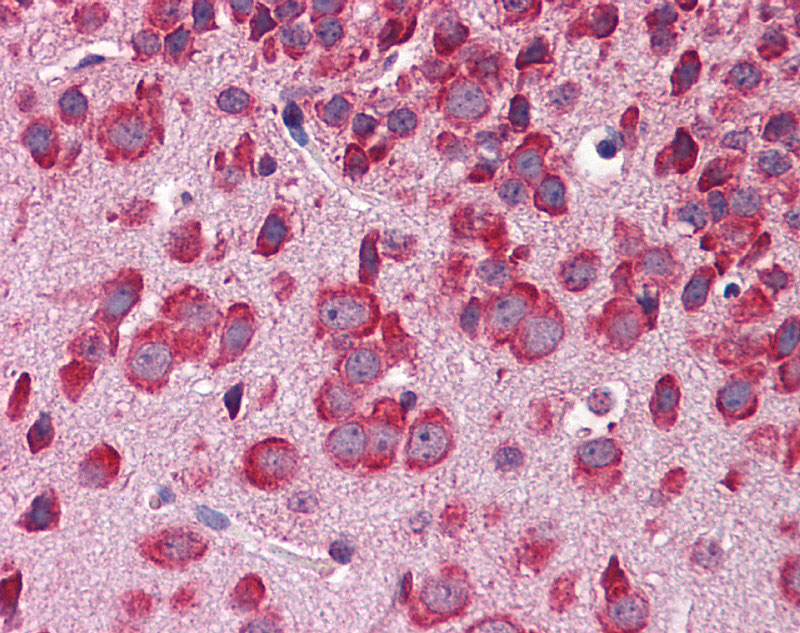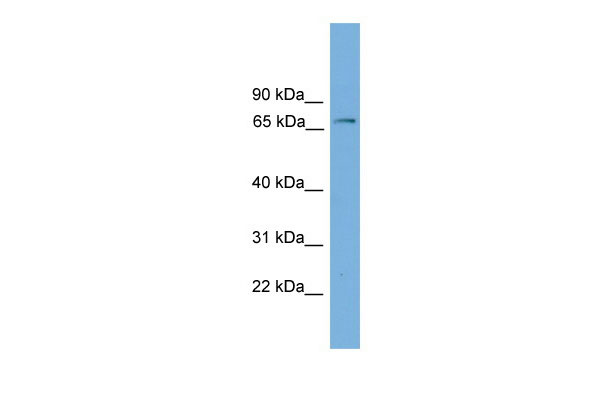Fbxw7 antibody - middle region
Rabbit Polyclonal Antibody
- 产品详情
- 实验流程
Application
| WB, IHC |
|---|---|
| Primary Accession | Q8VBV4 |
| Other Accession | NM_080428, NP_536353 |
| Reactivity | Human, Mouse, Rat, Rabbit, Zebrafish, Dog, Horse, Bovine |
| Predicted | Human, Mouse, Rabbit, Zebrafish, Chicken, Bovine |
| Host | Rabbit |
| Clonality | Polyclonal |
| Calculated MW | 79848 Da |
| Gene ID | 50754 |
|---|---|
| Alias Symbol | 1110001A17Rik, AGO, Cdc4, Fbw7, Fbwd6, Fbx30, Fbxo30, Fbxw6, SEL-10 |
| Other Names | F-box/WD repeat-containing protein 7, F-box and WD-40 domain-containing protein 7 {ECO:0000312|MGI:MGI:1354695}, F-box protein FBW7, F-box protein Fbxw6, F-box-WD40 repeat protein 6, SEL-10, Fbxw7 {ECO:0000312|MGI:MGI:1354695} |
| Format | Liquid. Purified antibody supplied in 1x PBS buffer with 0.09% (w/v) sodium azide and 2% sucrose. |
| Reconstitution & Storage | Add 50 ul of distilled water. Final anti-Fbxw7 antibody concentration is 1 mg/ml in PBS buffer with 2% sucrose. For longer periods of storage, store at 20°C. Avoid repeat freeze-thaw cycles. |
| Precautions | Fbxw7 antibody - middle region is for research use only and not for use in diagnostic or therapeutic procedures. |
| Name | Fbxw7 {ECO:0000312|MGI:MGI:1354695} |
|---|---|
| Function | Substrate recognition component of a SCF (SKP1-CUL1-F-box protein) E3 ubiquitin-protein ligase complex which mediates the ubiquitination and subsequent proteasomal degradation of target proteins (PubMed:21953459, PubMed:22748924). Recognizes and binds phosphorylated sites/phosphodegrons within target proteins and thereafter brings them to the SCF complex for ubiquitination (PubMed:22748924). Mediates ubiquitination and subsequent degradation of CCNE1 and MYC (PubMed:22748924). Identified substrates include cyclin-E (CCNE1 or CCNE2), DISC1, JUN, MYC, NOTCH1 released notch intracellular domain (NICD), NOTCH2, MCL1, MLST8, RICTOR and probably PSEN1 (By similarity). Acts as a negative regulator of JNK signaling by binding to phosphorylated JUN and promoting its ubiquitination and subsequent degradation (By similarity). SCF(FBXW7) complex mediates the ubiquitination and subsequent degradation of NFE2L1 (PubMed:21953459). Involved in bone homeostasis and negative regulation of osteoclast differentiation (PubMed:29149593). Regulates the amplitude of the cyclic expression of hepatic core clock genes and genes involved in lipid and glucose metabolism via ubiquitination and proteasomal degradation of their transcriptional repressor NR1D1; CDK1-dependent phosphorylation of NR1D1 is necessary for SCF(FBXW7)-mediated ubiquitination (PubMed:27238018). Also able to promote 'Lys-63'-linked ubiquitination in response to DNA damage (By similarity). The SCF(FBXW7) complex facilitates double-strand break repair following phosphorylation by ATM: phosphorylation promotes localization to sites of double-strand breaks and 'Lys-63'-linked ubiquitination of phosphorylated XRCC4, enhancing DNA non-homologous end joining (By similarity). |
| Cellular Location | Nucleus, nucleoplasm. Chromosome {ECO:0000250|UniProtKB:Q969H0}. Note=Localizes to site of double-strand breaks following phosphorylation by ATM {ECO:0000250|UniProtKB:Q969H0} |
| Tissue Location | Widely expressed with highest levels in brain, heart and testis. |
Research Areas
For Research Use Only. Not For Use In Diagnostic Procedures.
Application Protocols
Provided below are standard protocols that you may find useful for product applications.
终于等到您。ABCEPTA(百远生物)抗体产品。
点击下方“我要评价 ”按钮提交您的反馈信息,您的反馈和评价是我们最宝贵的财富之一,
我们将在1-3个工作日内处理您的反馈信息。
如有疑问,联系:0512-88856768 tech-china@abcepta.com.























 癌症的基本特征包括细胞增殖、血管生成、迁移、凋亡逃避机制和细胞永生等。找到癌症发生过程中这些通路的关键标记物和对应的抗体用于检测至关重要。
癌症的基本特征包括细胞增殖、血管生成、迁移、凋亡逃避机制和细胞永生等。找到癌症发生过程中这些通路的关键标记物和对应的抗体用于检测至关重要。 为您推荐一个泛素化位点预测神器——泛素化分析工具,可以为您的蛋白的泛素化位点作出预测和评分。
为您推荐一个泛素化位点预测神器——泛素化分析工具,可以为您的蛋白的泛素化位点作出预测和评分。 细胞自噬受体图形绘图工具为你的蛋白的细胞受体结合位点作出预测和评分,识别结合到自噬通路中的蛋白是非常重要的,便于让我们理解自噬在正常生理、病理过程中的作用,如发育、细胞分化、神经退化性疾病、压力条件下、感染和癌症。
细胞自噬受体图形绘图工具为你的蛋白的细胞受体结合位点作出预测和评分,识别结合到自噬通路中的蛋白是非常重要的,便于让我们理解自噬在正常生理、病理过程中的作用,如发育、细胞分化、神经退化性疾病、压力条件下、感染和癌症。







